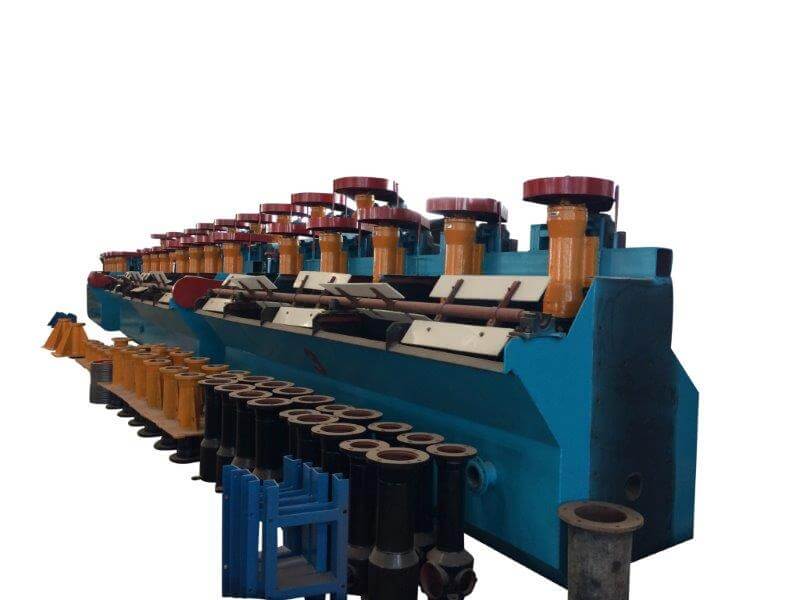Table of Contents
Qualitative Aspects
In its essentials, a flotation cell must provide for two main functions. First, it must supply air adequate in quantity and quality for satisfactory process kinetics. Air quantity can be defined on the basis of the narrow range provided in major U. S. commercial cells, for escape velocity, which averages near 1.2 m/min (4 ft /min). Air quality concerns bubble size, and to some extent bubble distribution patterns in the cell. Bubble diameter, which averages between 0.1mm/min and 1mm/min appears to depend more on the presence and concentration of frother than on any specific design features, although a minimum amount of turbulence is necessary to produce the shear necessary for bubble production. However, the flow patterns necessary for particle suspension (see below), are always more than adequately turbulent for bubble generation. The distribution of air throughout the entire cell volume was at one time considered essential for cell effectiveness; however, in most modern flotation cells the positive recirculation of mineral through the impeller region provides the counterpart of air sweeping.
The second important design feature is provision of a region above the impeller zone and below the froth relatively free of turbulence through which bubbles, water, and potentially floatable mineral pass en route to the froth.
The third feature is the provision of hydraulic flow adequate for particle suspension. In most modern cells this is the resultant of flow patterns and flow velocities generated by impellers. Purely pneumatic cells which obtain all hydraulic flow by compressed air injection without impellers are practically obsolete. However, several other concepts for impeller less cells are discussed below.
Two other processes contributory to flotation take place in cells: a) all or part of mineral/reagent interactions; and b) particle/bubble contacting. For the first, no special design features are required since the available turbulence levels are usually adequate. Where this is not the case, then the cell should not be relied upon, but separate conditioners should be provided. For the second process, since provision for the macroscopic requirements of aeration and suspension seems to provide automatically for adequate flotation results, it appears unnecessary to be concerned with the where and how of particle/bubble contact. This will continue to be so unless and until there is a clear demonstration of design features which both provide better mineral/bubble contacting and at the same time obtain better flotation results. Fallenius discusses this from the viewpoint of turbulence theory.
Quantitative Aspects
The motive power for mechanical cells is provided by impellers, but their overall performance is the result of the interactions among impeller-induced flow, baffles, cell walls and dimensions and fluid properties. Convenient characterization of the hydrodynamic aspects is provided by dimensional analysis. The fluid-moving capability is indicated indirectly by the Power Number (Np), which relates power consumption (P) to cell dimensions (D); fluid properties (f), and dynamics through the rotational speed (N).
Np = P/p N3D5………………………(1)
Since the impeller diameter is the only cell dimension correlated, on the assumption that all other dimensions are geometrically scaled, it is clear that Np will vary with impeller and cell design, even with the independent parameters H and D fixed. The important missing aspects are impeller height, number and shape of blades and the type and degree of baffling. Variations in Np reflect principally the effect of the total impeller/baffle configuration on the resistance of the pulp to displacement by the impeller, and thereby on the power drawn.
Table 1 collects Power Numbers for major U. S. cells and for a few others. The range in Np is approximately from 2 to 5. Values for mixing equipment in general vary from 0.3 for an unbaffled propeller to 6 for a 6-bladed flat turbine in a tank with 4 baffles appropriately dimensioned.
Air Flow
Harris summarized air flows for commercial cells in 1976. Two aspects need to be considered quantitatively. The first is the specific escape velocity (Qa/A) which eliminates cell size and mode of aeration from consideration and emphasizes the linear rate of escape of bubble air from the cell surface. This is the parameter directly related to flotation kinetics. The most widely used U. S. cells have the values outlined in Table 2.
Among other cell makes, the Heyl and Patterson CycloCell and Deister Flotaire have values near 0.6 m/min (2 ft/min); Outokumpu between 0.8 m/min and 1.5 m/min (2.4 ft/min—5.0 ft/min); Maxwell near 0.6 m/min (2 ft/min); and Sala 0.8 m/min (2.4 ft/min). The variations are not large, either with cell size or cell design. Older pneumatic cells, which used compressed air along without injection or impellers, had higher escape velocities, averaging 2.9 m/min (9-10 ft/min) for the Callow and Forrester designs. With these the fluid energy for air dissemination and suspension had to be supplied entirely by compressed air.
The second aspect of air flow for mechanical cells is the required balance with pulp flow as controlled by impeller speed. The Air Flow Number was proposed to indicate this balance, after it was shown to be important for coarse particle recoveries. Too much air in proportion to impeller speed tends to drop out the coarse while too little slows flotation rates. On the other hand, too slow an impeller speed also results in sanding, while too high a speed causes excessive turbulence and froth instability. The Air Flow Number should lie within a narrow range for optimum flotation results for any one cell. Harris gives values for most commercial cells while Table 4 has more detailed data for Denver and Wemco cells based on more recent measurements for sizes up to over 30m (1,000 cu. ft.). The average values are lower for the Wemco, 0.009 vs. 0.012, and decline as the cell sizes increase.

